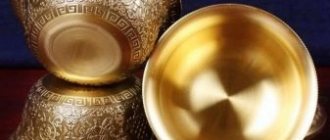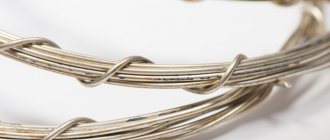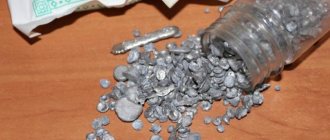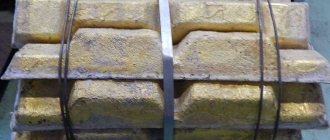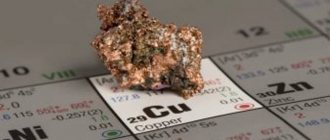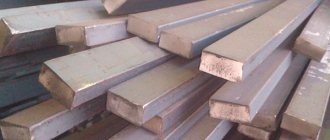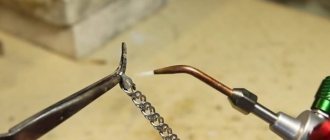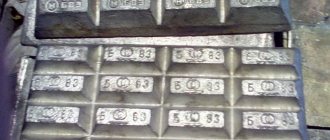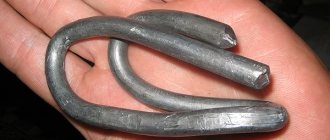- Jewelry alloy - what is it?
- Medical and other stainless steels
- Jewelry alloys without claims
- Alloy and other hint designations in alloys
- Titanium alloys
- Copper alloys
- Coatings of jewelry alloys Rhodium plating How is rhodium plating obtained?
- How durable is rhodium plating?
There are many little things that are useful when creating handmade jewelry. They are chosen based on style, size, fastening features or operation of the built-in tiny mechanism. And now all the external parameters of choice have been taken into account, but questions remain. How will the fittings you like in the product behave? Will the color change? Will it lose its shine? Won't it break? How many of these “li’s” confuse needlewomen, especially beginners, when selecting a clasp, end cap, frame, base. Well, the simplest pin becomes a reason for doubt when purchasing and bitter disappointment at the stage of assembling the jewelry or, even worse, when wearing it. To be less disappointed, let's talk about the variety of materials from which modern metal fittings are made. About their weight, strength, wear resistance and other features.
What's included
Since not all women and girls can afford to wear items made of gold, silver or platinum, jewelers use costume jewelry to make more affordable jewelry. What it is? The photos presented in the article demonstrate the varied beauty made from this material. These can be beads, earrings, clips, rings, bracelets, hair decorations (hairpins, headbands, crabs), brooches, etc.
When making an alloy, tin is most often used as a base. In its natural form, it is not suitable for the production of forged products, since it is refractory and brittle. Therefore, since ancient times, other metals have been added to tin. What else can be included in the alloy? This includes aluminum, copper, antimony, and any other metal that has hypoallergenic qualities and does not irritate human skin. When copper is added, the alloy becomes ductile, and antimony maintains the bright and sparkling appearance of the product for a long time.
Sometimes manufacturers use zinc as a basis in order to reduce the cost of jewelry. However, the appearance will be strikingly different from pewter.
What is a jewelry alloy and the reasons for combining different metals
Jewelry alloy is a mixture of precious and non-ferrous metals with more practical natural material properties. Most often used in jewelry production. Gold and silver are used as the basis, the amount of which can vary from 75% to 98%.
Jewelry alloy
Copper, palladium, platinum are often impurities. The use of additives is necessary to give the base hardness and resistance to deformation.
The combination of metals with different properties makes it possible to obtain a material in different colors: red, greenish, white, various shades of yellow.
Forbidden additives
It is noteworthy that already in the 19th century, jewelry alloy was widely used, the composition of which also included lead until the end of the century. But when scientists discovered that it remained on the skin, this additive was strictly banned. Today, the absence of lead in such alloys is prescribed at the legislative level.
Another forbidden metal that should never be in a good jewelry alloy is nickel. The reason for this is the negative effect of metal on the skin, which can result in an allergic reaction.
Jewelry steel for jewelry and its types
Jewelry (surgical, medical) steel is an alloy of iron, carbon and other alloying components with anti-corrosion properties. It is used not only in jewelry. The following are produced from steel:
- surgical instruments, some bone implants;
- expensive dishes;
- shells for some mobile phones;
- cases and bracelets of expensive watches;
- jewelry and luxury jewelry.
Cupronickel
A combination of several types of metals with increased strength, which is a cheap analogue of silver, is called cupronickel. Main components: iron, manganese, copper, nickel. The alloy is used in the production of sets, sets of dishes, dishes, jugs, and cutlery. Sometimes you can find cupronickel silver jewelry that is passed off as silver. Such items require special handling, as they quickly oxidize and change color.
What does the appearance say?
Jewelry craftsmen can simply figure out by eye what the jewelry alloy is made of. If the color of the product is slightly dull and matte, then tin plays the “main violin” in the composition. This decoration will be light, but brittle. If there is a reddish tint, then the alloy contains copper. In this case, the color will change slightly, since the aged look was originally intended. A yellow-green (sometimes yellow-gray) shimmer indicates the presence of brass in the composition.
Some jewelry alloys contain steel, and jewelry made from it has a corresponding gray, metallic tint or made to look like silver based on chromium. If the alloy product is too dark in color, this indicates the addition of nickel, which causes allergies in sensitive people. Less common are titanium alloys, which give jewelry durability and strength, but are many times more expensive.
Copper alloys
It was not without reason that copper became the first metal to be conquered by man. Beautiful, plastic, resistant to corrosion, easy to process and, in view of the still decent global reserves, not expensive either. In modern jewelry, copper in its pure form is practically never found. The metal is very soft and its properties are best revealed in alloys where zinc, nickel and other components are used as alloys.
The reddish tint and the ability to become covered with a noble patina are the first distinguishing features of any copper alloy. But in terms of other properties, copper alloys (of which the absolute majority are among costume jewelry) vary greatly. Let's look at the most popular ones that are used for making jewelry and accessories for it.
- Bronze in the classic version is a high-strength alloy of copper and zinc, but the classic version is not suitable for jewelry needs. The most in demand is the so-called “aluminum bronze”; from the name it is already clear that the main alloy is aluminum, which also makes the product lighter.
One of the advantages of this alloy is its warm golden-yellow hue. A brand new product can really shine, although not mirror-like, but quite bright. However, don't expect the factory shine to last forever. As with all copper alloys, oxidation and, as a result, darkening is inevitable. One of the significant disadvantages of aluminum bronze is its tendency to scratch.
- Cupronickel is a multicomponent alloy, where copper (70-80%) is diluted with nickel (20-30%), the main composition is supplemented by the addition of iron, manganese, and often silver.
The durable, hard, heavy alloy is distinguished by its external nobility: it looks like silver. By the way, cupronickel is our word, but outside the former USSR, alloys of similar composition are called “German silver”. Why German? But because “silver” coins from cupronickel were minted in Germany. But we love the alloy everywhere because it allows us to get jewelry that looks more expensive than its value. That is why Europeans have another name for it: “silver for the poor.” One of the disadvantages of the alloy is an unsightly dark coating, with which it instantly becomes overgrown. But this coating is easy to clean. So, in addition to cupronickel, they immediately buy products to care for it. At home, use a pharmaceutical solution of ammonia. With proper care, products last a long time.
- Nickel silver - the name translates as “new silver”; in fact, it is also an alloy of copper with zinc and nickel. In appearance it resembles nickel silver and is often confused with it.
However, there is a little more yellow in the nickel silver shade (deviations into blue and green are possible). Compared to cupronickel, the alloy is less durable and much cheaper, which is due to a significant difference in the proportions of the components: there is less copper in it, only about 40%, about 45% is zinc and about 15% is nickel. Hence the high probability of allergic reactions. Products made from nickel silver should be protected from moisture. It is better to store in a closed box, which slows down the process of oxidation and darkening. You can clean it by dipping it in a solution of soda, potash or gasoline. The alloy is often used as a basis for durable coatings, including silvering and gilding - with such products there is less hassle.
- Alpacas - in this case, it’s not about woolly calloused animals, but about an improved Mexican version of the previous silver-like alloy. In jewelry from those places, you can even see the production mark “Alpaca” or “Alpaca”: both options are correct, apparently they just didn’t agree on common spelling rules.
Alpaca contains about 60% copper, 20% nickel, 20% zinc. And the 5% addition of tin gives the alloy a grayish tint, additional lightness and ductility. It also darkens, and also quickly, but the patina looks aesthetically pleasing.
- Brass - and this alloy of copper and zinc imitates not silver, but gold. What does the English name of the alloy “yellow brass” mean – yellow copper. The alloy resembles gold not only because of its warm glow. The properties of brass grades L68 or L62 are so close to those exhibited by 583 gold that the alloy becomes a suitable training material for training jewelers.
Due to the long service life of the durable, corrosion-resistant alloy, it is called the “eternal metal”. Unlike bronze, brass is softer, which makes it easier to process, and more resistant to aggressive influences, such as salty sea water. And compared to steel, brass is heavier.
Brands of brass, in fact, differ in the content of zinc (from 5 to 45%) and additional additives; very harmful additives are possible, such as bismuth and arsenic, so brass fittings from an unverified manufacturer are fraught with unpleasant surprises.
The amount of zinc varies the properties of brass: the more it is, the stronger the alloy, without loss of ductility. But, at the same time, if the amount of zinc exceeds 20%, then rumors about the “eternity of the metal” become greatly exaggerated: such an alloy is susceptible to corrosion cracks, especially in high humidity and contact with ammonia fumes.
The amount of zinc in an alloy can be determined by the color of brass: if zinc is less than 20%, the color of the alloy is bright golden, orange-reddish, muted yellow shades indicate that there is 20-36% zinc, and a greenish tint indicates a high zinc content - from 36% and more.
Thanks to the abundance of brands, brass serves as a universal alloy used in various fields. Brass is used to make musical instruments and plumbing parts; it is successfully used in electronics and interior design. What is also appreciated in costume jewelry is that brass allows the casting of complex, detailed shapes. Such fittings are beautiful and durable even without galvanic coating. It is covered with a noble layer of greenish patina and looks like a museum rarity. With regular cleaning, patina can be easily avoided. There are special pastes for cleaning brass. At home, use a mixture of flour and salt in equal proportions, brought to a mushy consistency with a table solution of acetic acid.
Gold-plated brass is similar in appearance to noble metal. True, in terms of weight, although it is quite heavy, it is still inferior to gold, just as it is inferior in price. In general, it is not difficult to distinguish brass from gold. Brass is often attracted by a magnet, leaving behind a gray rather than yellow line on the ceramic surface, its color is less saturated, its shine is less pronounced. But, by the way, brass holds up coatings better than other alloys, so that under a layer of gilding, an amateur will distinguish it from gold only by the lack of hallmark. Brass also reliably holds galvanic coatings: chrome plating, nickel plating and the so-called “antique bronze”.
- Tombak (or tombak from the French Tombac). It has been used for a long time, therefore it has other names: similor, oreid, chrysochalk, chryzoin, princetal. In fact, this is one of the most decorative varieties of brass, which contains no more than 10% zinc. Alloys with a higher zinc content (up to 30%) are classified as semi-solid alloys.
- Tin alloys – silver-colored tin is lightweight, corrosion-resistant and non-toxic. However, the metal itself is brittle and refractory, which requires ligation with components that compensate for this deficiency. Among tin alloys, so-called pewters are used in jewelry making.
Pewters (alloys of tin with antimony, bismuth, copper, and sometimes lead) are characterized by aesthetics and ease of polishing. Copper gives such alloys ductility, aluminum gives strength, and antimony adds brightness. In terms of external qualities, slightly matte products reminiscent of platinum and white gold are magnificent; it is from them that convincing replicas of famous jewelry are often made. But due to harmful impurities, pewter in a number of countries is also an alloy prohibited in costume jewelry. Another disadvantage of pewters is their tendency to the so-called “tin plague”. Low temperatures provoke gray spots on the surface of pewter alloys and subsequent destruction, even crumbling into powder. In severe (below -30 degrees) frost this happens quickly. Chemical surface treatment or coating with decorative enamel mitigates the problem, but products made from tin alloys still require careful handling.
- Tibetan silver is one of the currently popular hoaxes that has nothing to do with historical Tibetan silver, and indeed with silver in general. Although the current costume jewelry and accessories are really similar to the jewelry created in ancient times in Tibet. In fact, this supposedly expensive alloy contains the same copper, brass and zinc. Depending on the proportions, the color of the alloy varies from yellow to reddish.
- Unnamed nickel-containing alloys - in many countries, jewelry alloys containing nickel are officially prohibited. But in our market the lion's share of inexpensive fittings is made from them.
The composition of such alloys is unpredictable; everything from iron to aluminum can be found in it. Fragility and darkening are a distinctive feature of such fittings, but their low cost makes them still in demand. In order to give the dubious alloy at least some tempting value, enterprising businessmen sometimes resoundingly call them “Monel”.
Monel is indeed a nickel-containing alloy and is quite respected. But accessories for jewelry are not made from it. Due to the high content of nickel, as well as iron, manganese and other additives that strengthen it, the alloy is difficult to process. It is used to make durable zippers, rivets and other reinforced fittings for outerwear, bags, etc. Jewelry needs do not require such strength.
Coating options
Often, finished products are coated with various compounds, since the jewelry alloy contains metals that lead to darkening. For example, for a bright, expensive shade, gilding or silver plating is chosen, and for an interesting antique color, it is coated with copper or bronze. Brass and chrome plating is more often seen not on jewelry, but on furniture accessories. And such an option as gold leaf is used by craftsmen as a covering for church domes, decorative frames for icons, pectoral crosses, etc.
History of discovery
There is no exact information about when the first jewelry alloys appeared, but it is believed that even before our era, monarchs, rulers, and military leaders decorated their homes with various metal products, which were inlaid with precious and semiprecious stones.
The concept of “jewelry alloy” appeared in the 19th–20th centuries, when similar materials were separated into a separate group. From that moment on, jewelry began to actively spread throughout the world.
Golden Lion (Photo: pixabay.com)
Advantages
All products for the manufacture of which jewelry alloy is used have a number of positive characteristics. If we talk about jewelry, then everyone knows the fact that costume jewelry is much cheaper in price than products made from precious metals and stones. It is characterized by wide availability, as it is sold in many stores and supermarkets. Health safety is no less important: the alloy composition does not contain any elements that irritate the skin, so the products can be worn by almost everyone.
Reviews
It turns out that now even certified jewelry stores sell costume jewelry. The price of several thousand rubles often makes one think that this is low-grade silver. Outwardly, they are practically indistinguishable. Only after purchase and careful examination can you find defects that indicate that this is high-quality jewelry. But a pleasant bonus is a guarantee from stores, which was not the case before.
Nastya Z. g, Moscow
Roman D. g, Murmansk
There are many inexpensive alloys that can be used to make home decorations. All of them, when properly processed, resemble expensive jewelry, but are much cheaper. By experimenting with the composition of the alloy, you can change the color of the jewelry, and even the style. Using base metal mixtures is an excellent alternative for those who are passionate about jewelry making.
Pandora is one of my favorite jewelry brands. At the same time, the collection of Pandora Rose jewelry with an unusual pink tone attracted special attention. I was sure that the jewelry was gold. It turns out that the peculiarity of this line is that it is silver, and this color is obtained due to the addition of copper and applied gilding. Despite this, the entire series pleases with its unusual figures, sophistication and warm shine.
Valentina P., Donetsk
Flaws
In addition to positive qualities, jewelry alloy also has negative ones. So, it cannot withstand constant bending and may break. Also, any product made from such an alloy does not have long-term wear resistance and, if exposed to an aggressive environment, quickly changes its appearance and becomes unusable. For example, women often swim in the sea without taking off their rings and earrings. But salty sea water immediately begins the process of destruction. If they are made of a jewelry alloy, then at best they can simply change color. Any acid and alcoholic drinks have an even worse effect. You can put food vinegar, any detergents and even some medications on a par with the previous destroyers. In no case should manganese come into contact with the alloy, because it is very difficult to wash off.
What is the jewelry material coated with?
Regardless of the composition, all products are covered with an additional protective layer. To preserve the shine and appearance of jewelry longer, the following is used to cover them:
- eloxal - can be used in the production of jewelry, but most often it is a protective layer. The coating is applied with aluminum oxide, which allows you to change the color of the product in the process.
- rhodium – characterized by durability and hardness of the coating. Not exposed to water, fat, acids, retains natural shine. Rhodium electroplating is used to protect jewelry.
- varnish is a popular budget product for jewelry or silver. The protective layer does not allow external substances to come into contact with the metal, enhances shine, but does not last long. Over time, the protective coating will need to be restored.
Rules of care
When buying jewelry in stores, fashionistas often ask: does jewelry alloy darken or not? The answer is simple: it darkens under the influence of the external environment. Even with daily contact with the skin, a reaction may occur and the alloy will tarnish. The only exception here is products with a durable galvanic coating.
How should you care for accessories made of jewelry alloy? You should not allow contact with water, soap and shampoos, various chemicals, you should avoid temperature changes, and protect from hairspray, perfumes, and deodorants due to the content of acidic substances in them.
How to clean up falling debris and dirt? Cotton, flannel or special fabric napkins are used. To prevent deformation, you need to remove jewelry when playing sports (running, swimming, fitness), as well as when performing repairs, especially when working with paints and varnishes.
Products must be stored separately from each other to avoid a chemical reaction between them.
Where is costume jewelry made?
There are several main countries that can boast of the quality of their products. They prove that costume jewelry can look much better than gold jewelry.
- Italy is a leader in the production of costume jewelry. The jewelry that is made there is very popular all over the world. Murano glass is produced on the island of Murano, which is distinguished by its unusual appearance. The jewelry is handmade by the best Italian jewelers. This type of jewelry is not budget friendly.
- France. There are several companies in this country that specialize specifically in the production of costume jewelry.
- The Czech Republic is famous for its pomegranate products. Jewelers use the alloy “tompak”, which does not cause allergies in humans.
- Belgium is distinguished by good quality jewelry. They serve their owner for a long time and do not darken.
To avoid deformation, all jewelry should be removed during intense activity, such as running or fitness. To extend the life of jewelry, it is better to wear it only when going out and take it off when performing household chores.
Properly selected jewelry can highlight the beauty and complement any look. Nowadays, massive jewelry made from alloy jewelry is in fashion - these are weighty bracelets and pendants in a geometric design. It’s also worth taking a closer look at the new trend – brooches. They are distinguished by their varied appearance and shape.
Metals in jewelry alloys
TIN
If there is a lot of tin in the alloy, then the output is matte shades of gray. Such alloys are light, but not strong and brittle. Products of Chinese origin demonstrate similar quality.
When copper predominates in the alloy, the color turns out to be more brown, and the metal has an antique effect. A large presence of copper is typical for Czech jewelry. When buying jewelry, do not forget that for copper compounds, oxidation in air is a natural process. Copper products darken over time, so they need to be cleaned regularly. Methods for cleaning copper products include rubbing the surface with a soft cloth until polished. Never use solutions containing cleaning agents.
BRASS
Similarly, brass is used, which is essentially a copper-based alloy. Products made of brass have yellowish-green shades with an admixture of gray. The color is somewhat similar to bronze, but may vary due to other components. Brass has found application in the manufacture of decorative elements in the antique style by Czech manufacturers.
ALUMINUM
Aluminum is also favored by jewelry manufacturers from the Czech Republic. It is close in color to steel, just as glossy and shiny. Steel added to alloys increases strength. Used in the production of fashion jewelry.
NICKEL
Nickel is an almost black metal. Easily oxidized. When contained in large proportions in the alloy, it can cause allergies. For this reason, many women refuse to wear Chinese-made jewelry.
RED BRASS
Note that the basis for the jewelry of Czech companies was the tombak jewelry alloy (90% copper and about 10% zinc). It is characterized by a high degree of resistance to corrosion processes, as well as increased ductility. It does not contain nickel, which is dangerous to the body. Typically, earrings are made with studs made of titanium, which is a medical material that does not cause allergies.
All products manufactured in the Czech Republic are tested in accordance with Czech state standards.
How to preserve the original appearance of jewelry longer?
If we are talking about inexpensive jewelry from Chinese and Korean manufacturers, then it is better not to wet it with water, keep the jewelry separately from each other, or better yet, each in a separate bag/package to prevent air from entering as much as possible. Before putting on the jewelry, do not apply perfume and hand/body cream. Never spray cosmetics on your jewelry.
Most women do not allow themselves to go out without accessories. Some people prefer jewelry, while others prefer costume jewelry. The most common material among jewelry manufacturers is jewelry alloy. It is from this that beads, rings, earrings, toggles, earrings, etc. are made. In this article we will try to figure out what this material is and how to properly care for it.
Lead in Jewelry from China – What is Dangerous and How to Avoid
/ Products / Costume jewelry / Lead in jewelry
More and more buyers around the world are paying attention to the content of hazardous metals in jewelry – primarily lead and nickel. In the USA and several European countries, costume jewelry is subject to mandatory certification and inspection, and the sale of jewelry containing lead is strictly limited.
Why is lead content dangerous in jewelry? Is it possible to guarantee lead-free jewelry in China?
Why is lead dangerous?
Lead is a toxic metal. When it enters the body, it negatively affects the liver, kidneys, brain, and accumulates in bones and teeth - from where it can later be released again. There is no minimum safe level of lead in the body.
It is most dangerous for pregnant women (as it affects the fetus) and for children under six years of age. Children with elevated levels of lead in their bodies may experience developmental delays, behavioral problems, damage to the nervous system, cause seizures, and even death in high concentrations.
The damage caused to a child's nervous system and brain development due to lead poisoning is irreversible. High levels of lead in a pregnant woman's body can lead to miscarriages, premature fetal death and other consequences.
How dangerous is it to wear lead jewelry?
Lead enters the body through inhalation of vapors and microparticles, as well as through water and food (pipes with lead solders, dishes containing lead, etc.).
Lead practically cannot enter the body through the skin. Therefore, the danger of jewelry that comes into contact with the skin is practically zero.
But, when ingested, lead is absorbed into the blood. Some people “chew” jewelry - a bad habit, especially for children - they put everything in their mouth. With such “chewing,” there is a 100% chance that lead from jewelry will enter the body. And then the only question left is how much lead you “ate.”
Are there any special requirements for certification of costume jewelry from China?
In Russia, costume jewelry is not subject to mandatory certification (only voluntary) - therefore, jewelry even entirely made of lead can be safely sold on the Russian market.
Although there are exceptions to this rule:
1) Large retail chains buy only jewelry that has passed voluntary certification and tests. Accordingly, it will be safer to buy jewelry there.
2) If costume jewelry is intended for children, it must be tested by Rospotrebnadzor, which also gives certain guarantees. Unless, of course, it was brought to Russia “in white”.
Cheaper
Costume jewelry is mainly made from either zinc or lead alloy. Lead-based alloy is at least 30% cheaper than zinc alloy. The product will be cheaper in the end.
Easier to produce
When casting a product from a lead alloy, you can use cheap rubber molds, while when casting a product from a zinc alloy, you can use expensive silicone and metal ones. Rubber molds last longer, the melting point is lower, and in general it is much easier to produce jewelry from lead alloys.
Soldering connections - beads, chains, small jewelry elements. The easiest way to solder is with lead. Which is what many manufacturers do.
High quality
Have you seen bubbles on jewelry? When does the top coating of a product peel off? They say it's of poor quality. So, such defects are much less likely to be seen on jewelry made from lead alloys. It will seem like higher quality jewelry.
Plus, products made from lead alloys are heavier and more massive - for buyers they seem more “expensive”, more solid. This adds purchasing value to the product.
Is it possible to guarantee lead-free jewelry in China?
I’ll tell you about the situation in our city of Yiwu, where the largest wholesale jewelry market in the world is located - about 6,000 suppliers.
As a rule, the question from buyers is “do you have lead-free jewelry?” To which in almost 100% of cases you will receive the answer “yes, lead-free”. Buyers from Europe and the USA have “trained” suppliers to respond in this way - otherwise no one will buy anything.
Don't completely trust words. Jewelry may contain some amount of lead, especially for jewelry that consists of many small parts - they will almost always be soldered using lead.
Many manufacturers purchase “parts” for jewelry production from third-party suppliers—they simply cannot guarantee that these parts are lead-free. They don’t know themselves.
The cheaper the product, the higher the chance that it is made of lead alloy. If low price is your main concern, your shipment will likely contain toxic metals.
The only way to avoid such problems is to have the product tested at a laboratory in Yiwu, which your export agent can help you with. Only such a test will give you complete confidence that the jewelry will not contain toxic metals.
Contacts
- Are you planning to wholesale jewelry from China? Buying online, on websites is not profitable. The best prices are at the wholesale market in Yiwu, China.
- Costume jewelry from China wholesale - how and where to buy directly, find suppliers? Why is Yiwu market the best place to buy?
- How to start producing jewelry under your own brand, your own designs, without huge costs
- Find out more about the city of Yiwu, China - general information, wholesale market, history and modernity.
- Your representative in Yiwu is an agent on the wholesale market: product search, travel support, quality control, warehouse, delivery
- Professional mediator in Yiwu China. We are different from other companies - find out more on the website
Source: https://www.predstavitel-v-kitae.com/lead-free-jewelry.html
